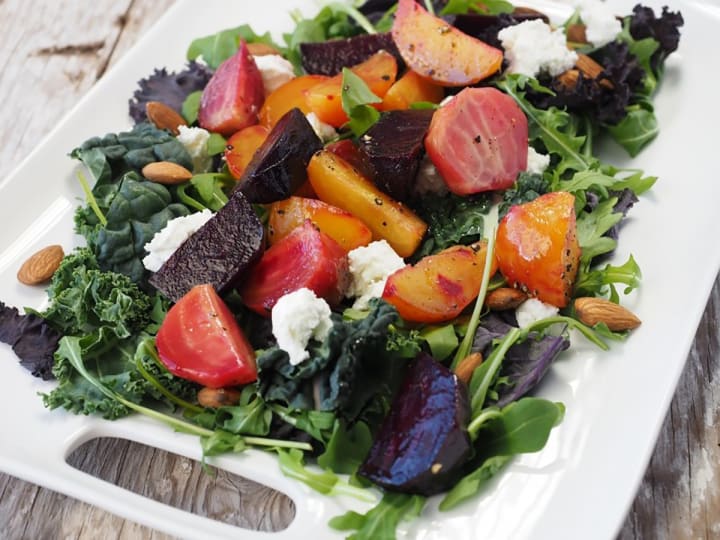Benefits of Eating Salads
The benefits of eating salads include combatting illnesses and keeping you healthy!

What’s not to like about salad? Sure its not a big juicy burger, but eating salad is a smart way to keep up nutritionally and developing a one-a-day habit could actually prolong your life.
A couple of long-term studies bear this out. In years of tracking the frequency of fruit and vegetable consumption versus the mortality rates of 25,000 a group of individuals, researchers found that regular salad eaters lived longest. And a Belgian study of 200 men found that those who ate most of their vegetables raw had fewer colorectal cancers than those who didn't.
Researchers have some clues as to why: The fiber in legumes, vegetables and whole grains is heart protective, and leafy green vegetables are excellent sources of the antioxidant vitamins A and C; the sulfur compounds in onions and garlic and the indoles and dithiolthiones of cabbage, broccoli and other cruciferous vegetables are being scrutinized for their chemopreventive capabilities. “But there are other compounds in standard salad ingredients that have yet to be discovered," says Mark Messina, Ph.D., a nutritionist with the NCI. That's why the scientific consensus boils down to a sensible suggestion to eat a variety of fruits and vegetables. At least five servings daily, advises the NCI. “A serving for leafy greens is a half cup, so a generous salad could easily supply three helpings worth at a single meal." It also gives you the long-life benefits of eating your vegetables raw.
Add Longevity to Your Salad

Image via Visual Hunt
Then again, the "health quotient" of your salad depends on what you toss in the bowl. Include these key anti-aging ingredients:
Beta-carotene: This plant form of vitamin A (typically found in orange, green and yellow vegetables) has been shown to protect against cancer of the stomach, lungs, bladder, esophagus and throat. The amount needed to ensure this kind of protection: 12,500 international units (IU) daily, or two and a half times the recommended daily allowance (RDA), says Ronald Ross Watson, Ph.D., an immunologist and cancer researcher. Sounds a bit daunting, but it's more than do-able with just one large carrot (31,000 IU) or a big stalk of broccoli (12,000 IU).
Vitamin C: Found in tomatoes, peppers, broccoli and other dark leafy greens, vitamin C may be another anticancer (stomach, colon, pancreas) nutrient. To reap its protective effects, many experts set daily intake at what some would call modest levels—200 to 250 milligrams (mg)—even though this is four times the RDA. While citrus fruits are your best sources, vegetables—especially green and red peppers—can help nudge up your daily total.
Calcium: This bone strengthener has also been shown to lower the risk of colon cancer. The best sources are dairy products—among these, yogurt is a superstar. "Calcium absorption is increased in its acidic medium," says Cedric Garland, Dr.P.H., director of the Cancer Center Epidemiology Program at the University of California, San Diego. What goes into your salad can also boost your calcium.
Fiber: The most intriguing news here is that the soluble type (found in vegetables and fruits) isn't only proving to be a key factor in cancer and heart disease prevention, but in calcium absorption as well. Pectin, a form of vegetable fiber, seems to transport calcium to the large intestine and slowly release it, upping absorption, says Garland. Eat vegetables rich in both—basically any member of the cruciferous family (broccoli, cauliflower, cabbage, etc).
Long Life Salad Ingredients

The chart above helps to take the guesswork out of salad mixing:
- Eat at least three cups per day (two side salads or one big entrée salad).
- Include at least two top sources of Vitamin A, two C-rich edibles and One high-calcium vegetable. These are the three-star foods on the chart. Two- or single-star items are still good bets, but you'll need to toss in more of them.
- Figure about two grams of fiber per cup of salad; a cup of super-high kidney beans will add another 15 mg of cholesterol-lowering fiber.
- Last but not least, add the dressing—ours, naturally. Not only does it have the clout of calcium but the bonus of basil, a good supplementary source of many antioxidants such as beta-carotene and vitamin C. What about foods that aren't featured on the above list? As long as you've got your nutritional bases covered with the starred foods, mix in whatever other vegetables you like to reap the benefits of eating salads.
Yogurt Basil Dressing
- 1 c plain low-fat yogurt (or 1/2 c plain low-fat yogurt and 1/2 c tofu)
- 1/2 c packed fresh basil leaves, chopped
- 1 or 2 garlic cloves
- Juice from 1/2 a lemon
- 2 tsp extra virgin olive oil
Combine all the ingredients in a blender or food processor and blend for 30 seconds. Chill before serving. To store leftover dressing, cover and refrigerate. It will keep for several days.
Created from a single piece of cherry wood by the craftsman at Holland Bowl Mill, this chopping bowl set is perfect for presenting a salad to guests or when you're chowing down solo. Complete with a mezzaluna knife for chopping, this bowl set is also great if you are just preparing ingredients for a healthy meal.
About the Creator
James Porterson
Former obese teen turned nutritionist. Enjoys writing about staying active and proper nutrition.






Comments
There are no comments for this story
Be the first to respond and start the conversation.